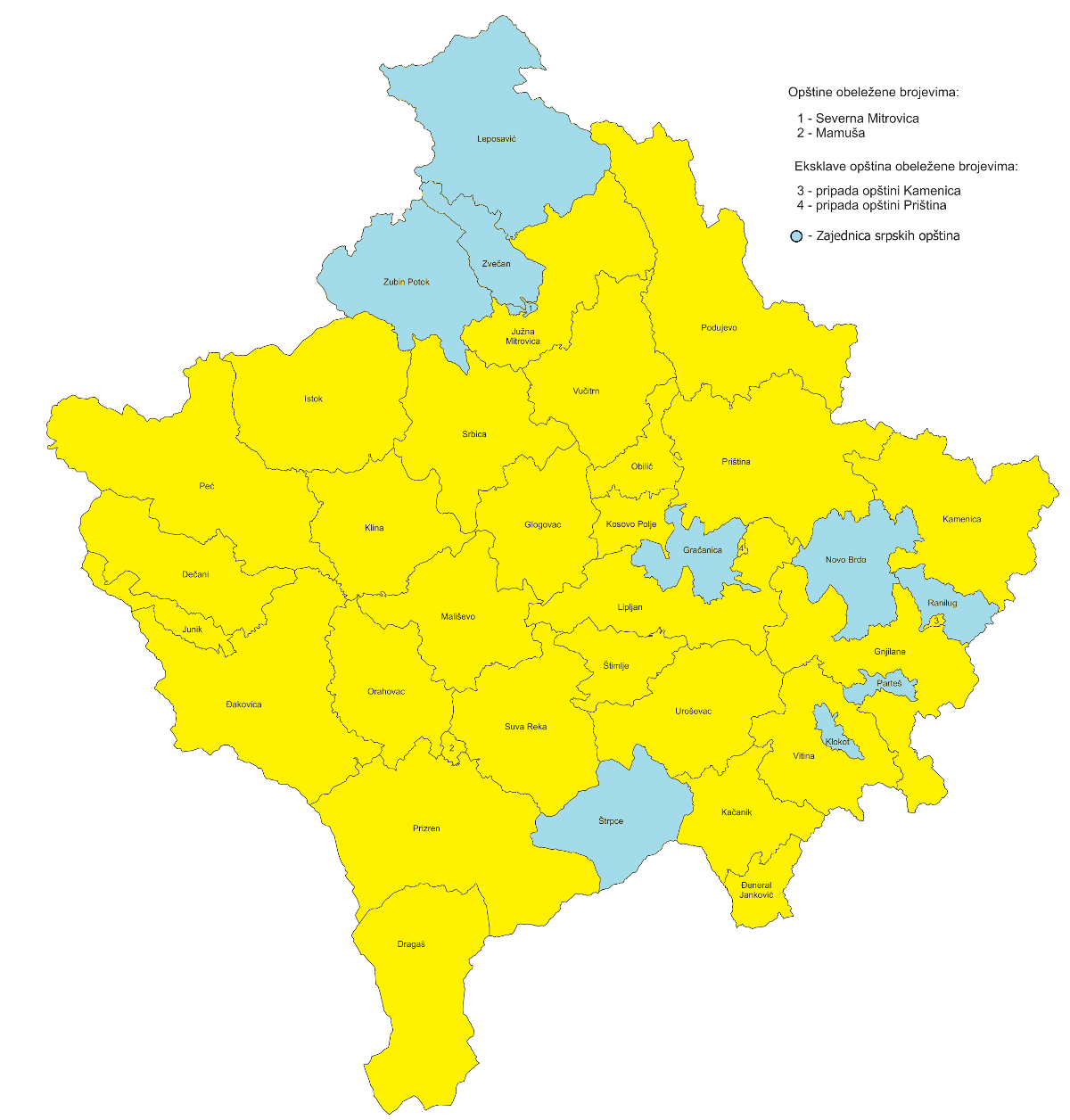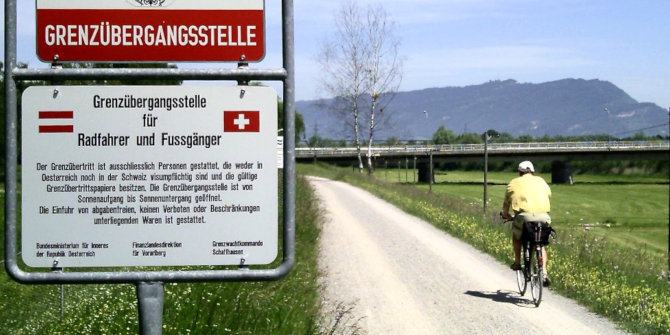 The prospect of Kosovo and Serbia exchanging territories received significant attention earlier this year. Beáta Huszka argues that while much of the reaction to the proposal was negative, a well-managed exchange based on domestic consensus and the mitigation of regional risks could have a stabilising effect for both countries. However, securing these conditions would be highly difficult in practice, and the success of the land-swap would be far from guaranteed.
The prospect of Kosovo and Serbia exchanging territories received significant attention earlier this year. Beáta Huszka argues that while much of the reaction to the proposal was negative, a well-managed exchange based on domestic consensus and the mitigation of regional risks could have a stabilising effect for both countries. However, securing these conditions would be highly difficult in practice, and the success of the land-swap would be far from guaranteed.
On 14 March, Serbian President Aleksandar Vucic, while talking to Wess Mitchell, the U.S. Assistant Secretary of State for European affairs, said that his country was ready for a compromise with Kosovo but not for “a humiliation of our own people”. Ever since, there has been speculation about the possibility of a land swap between Kosovo and Serbia as a way to end the dispute over Kosovo’s statehood.
At the European Forum Alpbach in Austria at the end of August this year, Vucic, together with his Kosovo counterpart, Hashim Thaci, made clear during a panel discussion that they were considering the possibility of territorial changes. If the two sides manage to agree on some form of final settlement, this would allow Kosovo to gain full international recognition while also removing the greatest obstacle to Serbia’s EU accession.
However, it is worth remembering that the idea of an exchange has never been officially endorsed or negotiated by the two sides. So far, both presidents have been talking about the territories they might want to recover without admitting that it might require also handing over some territories of their own. Since no leader in their right mind would give over some part of their country’s territory without gaining anything in return, it has been tempting for observers to read between the lines and assume that Vucic and Thaci have in fact been floating the idea of trading territories. But before jumping to any conclusions, it is worth emphasising, as Robert Cooper from the ECFR recently pointed out, that “so far, no one has proposed anything concrete. We hear of ideas, but they are rather vague”.
Who is for a land swap and who is against?
The possibility of a land swap has triggered strong reactions inside the two countries and beyond. With a few notable exceptions, hardly anyone seems to be in favour of the idea. Kosovo’s Prime Minister, Ramush Haradinaj, came out strongly against it, as did key opposition parties in Kosovo. Similarly, the Serbian Orthodox Church and many Serbs living south of the Ibar river have expressed dismay at the prospect. Only Albanian politicians from the two Albanian majority municipalities in southern Serbia of Presevo and Bujanovac appear enthusiastic about the potential of being integrated into Kosovo.
An indication that Belgrade is serious about pursuing a land swap came on 4 September when Serbian representatives of Srpska Lista, a Serbian minority party in Kosovo which has close ties with Vucic’s Serbian Progressive Party, decided not to attend Kosovo’s parliament during a vote initiated by the opposition. The vote, which aimed to withdraw the negotiating mandate from President Thaci, could have put future talks on territorial exchanges in jeopardy.

Credit: CC0 1.0
The response from the international community has been relatively lukewarm. Most of those presented as backing the deal have simply indicated they would not oppose it if the two sides come to an agreement. This includes President Trump’s national security advisor, John Bolton, as well as Federica Mogherini, the EU’s High Representative for Foreign Affairs and Security Policy, and Johannes Hahn, the EU’s Neighbourhood and Enlargement commissioner. A few EU member states, such as Belgium, Romania, Hungary and more recently Austria have taken a similar position. International opponents have been more explicit and vocal in their opposition, among them the leaders of Germany, the UK, France, Finland and Luxembourg. Serbia’s Balkan neighbours have also communicated their concerns, notably Croatia, Bosnia and Herzegovina (with the exception of Republica Srpska), Macedonia and Montenegro.
The risks
The arguments against adjusting the borders abound and could be heard many times even before the current situation. Probably the most important one concerns fears about destabilising spillover effects: what would happen if some nationalists applied the same logic of adjusting borders according to ethnic lines in Bosnia and Herzegovina or Macedonia? That could result in Albanians in Macedonia and Serbs in Republica Srpska (RS) mobilising for secession, potentially leading even to the outbreak of violence.
While such fears should not be dismissed out of hand as nationalists in both countries have at times been stepping up their demands, there is a big difference between the current situation in Kosovo/Serbia and the situation in these other countries. Namely, if territorial exchange happened between Serbia and Kosovo, it would happen by consensus. A similar consensus in Bosnia and Macedonia under the current circumstances with the present actors is pretty much unthinkable. It is worth remembering that before Montenegro separated from its union with Serbia, the same warnings about potential spillover effects to other parts of the Balkans were echoed, which is why Montenegro had to wait until 2006 to proclaim independence. In the end, Montenegro achieved independence via a process managed according to an agreement with Serbia and the EU, without any negative repercussions.
One could argue that it was a very different situation because internal borders were not modified, with separation happening along the established borders between the two republics – who by the way had held the right to pursue secession under the old Yugoslav constitution. This is not the case in Kosovo, where the border would have to be changed. Modifying borders has been off the table since the Yugoslav dissolution. Accordingly, even though many countries separated from Yugoslavia, and from its successors, no internal border has been modified during any of these processes.
Yet, changing internal borders is not as unthinkable as it looks at first glance. It is less well known that Kosovo’s northern border – which is under dispute in the current debate – was modified during Tito’s time in 1959 when the municipality of Leposavic was added to Kosovo, which was an autonomous province of Serbia in Yugoslavia. It was an important change considering that this municipality constitutes the greatest part of the territory of North Kosovo (i.e. Kosovo north of the Ibar river, as shown in the map below).
Map of Kosovo with Serbian majority areas highlighted in blue
Credit: Wikimedia commons (CC BY 3.0)
The other important counter-argument is that “such a territorial swap is legitimising a dangerous propaganda of ethnic ownership over the territory – a principle that has pushed the region on several occasions into bloody conflicts”. However, a territorial swap of this nature is not going to fulfil the abominable goal of establishing ethnic ownership over territories, as the aspiration of increasing ethnic homogeneity would be only partially realised.
North Kosovo joining Serbia would be the least controversial change as there are very few Albanians and other minorities living there. According to OSCE estimates from 2015, the four municipalities north of the Ibar river – Leposavić, Zvečan, Zubin Potok and North Mitrovica – have 79,910 inhabitants. Around 70,300 (88%) of these are Serbs, 6,970 (9%) are Albanians, and 1,500 (2%) are Bosniaks. Yet, the majority of Kosovo Serbs live in the south, and their position would undoubtedly be weakened by losing their ethnic kin in the north. By contrast, southern Serbia is home to many non-Albanians, among them around 18,000 Serbs, (and even more, around 25,000, if we add Medvedja to its territory). Thus, at least 25% of the population is composed of ethnic Serbs, (or more if we include Medvedja).
It is difficult to imagine that these people would be ready to live in Kosovo. It could be argued that Kosovo could accept giving up the north without getting Presevo Valley as international recognition would be the greatest price for Pristina. North Kosovo anyhow has not been an integral part of Kosovo since 1999, so it would not be such a huge loss for Kosovo if its northern part formally separated. However, it is unlikely that it could be sold politically in Kosovo in the face of strong resistance from opposition parties and public opinion.
The benefits
The arguments in favour of the land swap are that it would allow for normalising relations between the two countries, enabling Kosovo to gain full international recognition and Serbia to move ahead with EU accession. Serbia will not recognise Kosovo without some serious concessions. Without such a radical agreement it is difficult to imagine how the two countries could move forward from the current deadlock, which is unsustainable. As Ivor Roberts, former ambassador of the UK to Yugoslavia, has rightly pointed out, “the reality is that no course is without risks, and the present impasse is not risk-free, either”. Without international recognition, life in Kosovo is going to remain a challenge, which has obvious security risks, not to mention Serbia getting into a deadlock with its EU accession.
Key conditions: Domestic consensus and the regional environment
Getting into a serious discussion about a possible land swap is therefore a high risk-high reward gamble. The truth is that no one can predict what would happen afterwards. Such a deal could well bring the impasse between Kosovo and Serbia to an end. Yet, things could also go wrong easily. While Vucic seems capable of asserting control over the various actors in Serbia and the Serbian politicians in Kosovo for a deal to be implemented, Thaci seems less able to forge the internal support such an agreement would require. Without a certain degree of domestic backing, the agreement could not be carried out, or could be messy and possibly even violent, in light of Vetevendosje’s more recent violent actions in parliament. Therefore, a considerable degree of internal support is a necessary requirement for any settlement to succeed. Yet, this will not prevent the mentioned negative repercussions from occurring in other parts of the Balkans.
By looking at the experience of other negotiated settlements in the region, I have argued elsewhere (alongside my co-author Erin K. Jenne) that stability in the regional environment is key for territorial settlements to work. Conflict spillover from neighbouring countries, deadlock in NATO or the EU integration process, and interventionist kin state activism can fuel discrimination against minorities or separatism by minority organisations, which can result in conflict.
Examples include Macedonia following the signing of the Ohrid Agreement in 2001. Ethnic relations began to deteriorate after 2008 when Macedonia’s NATO and EU accession was put on hold because of the name dispute with Greece. Thus, it can be assumed that if Macedonia manages to solve the name issue with Greece, its EU accession might receive new momentum, taking the wind out of the sails of nationalist troublemakers. In Bosnia, the situation is more complicated, yet without outside support, such as from Serbia or Russia, Bosnian Serbs are unlikely to take the risk of outright secession and a possible conflict in the face of internal and international resistance.
Since the summer, Kosovo-Serbia relations have been on a downward spiral, most recently owing to Kosovo’s unilateral imposition of customs tariffs on Serbian and Bosnian products. The current political atmosphere is definitely not conducive for reaching a compromise between the parties. However, the idea could be put back on the agenda if talks gain better momentum. A well-managed land swap which is based on domestic consensus and the mitigation of regional risks could have a stabilising effect for both countries. Yet, securing these conditions is no small feat, and its success cannot be guaranteed – and herein lies the risk.
Please read our comments policy before commenting.
Note: This article gives the views of the author, not the position of EUROPP – European Politics and Policy or the London School of Economics.
_________________________________
 Beáta Huszka – ELTE University
Beáta Huszka – ELTE University
Beáta Huszka is an Assistant Professor at the Department of European Studies in ELTE University, Budapest. She completed her PhD in International Relations at the Central European University in 2010.





